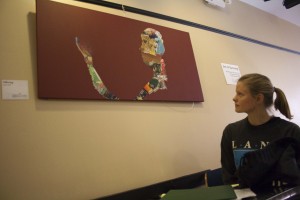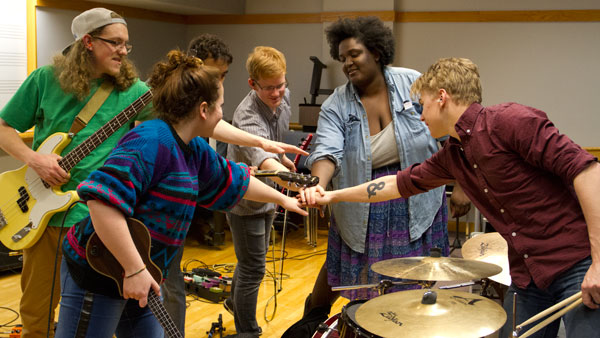
Paralleling the taupe-colored walls of Waffle Frolic’s upstairs seating, a dozen mismatched frames hang above the tabletops on the outskirts of the lofted area. Within the frames is the artwork of sexual assault and child sexual abuse survivors. In honor of Sexual Assault Awareness Month, the Advocacy Center of Tompkins County is sponsoring the exhibit, titled “The Art of Surviving.”
While some of the works feature an “About” section to lend insight to the artist’s creation, others do not. Instead, the creators allow the powerful images of their “healing art” speak for themselves.
“The Offering,” the largest piece on display, greets viewers at the top of the stairs. The 3-by-4 foot, deep maroon canvas displays a human figure made of magazine clippings whose intriguing form instantly captures viewers. The news strips are meticulously organized to shape the figure. Its arm extends from the neck and forms a U-shape with a palm raised in front of its face. The figure’s uplifted hand radiates short, delicate streaks of violet paint, as if looking into a hand-held mirror, which indicates some sort of offering to a deity or even itself.
On the opposite wall, a blood-red canvas depicts a ghost-white silhouette sprawled across the floor. Next to the untitled painting is a poem that begins with the lines, “An intruder/walked in with muddy shoes.” Two black footprints the size of the victim’s painted body dominate the image. The violent color scheme paired with the poem’s helpless tone scream out the painful experience.
To the left, a series of four color photographs of people’s wrists are stacked in a vertical frame. “The Binding Project” depicts the work of the same-named campaign that unites people across the United States to shatter the silence of sexual violence. Blending art, education and dialogue, the project uses zip ties as a self-empowerment tool against their perpetrators. Each of the works depict an inspiring word written on the wearer’s zip tie: Love, Trust, Breathe and Overcome. The first three pictures are lightly exposed while the last has a sepia tone that artfully emphasizes the power of all the victims’ ability to overcome trauma.
Mimicking the styling of a magazine-stripped collage, Susan A. Dalaba’s piece, “The Woman I Want To Become,” speaks powerfully to survivors of sexual assault. The three images have a sketch-like texture, which makes the clippings appear expertly hand drawn. Each one depicts a bodice coated in strips of inspiring phrases that are layered in different positions. The first displays a body whose breast is facedown on a forest-green cloth with words like “Thankful,” “Strong” and “Dream” rising to the surface. The second bodice is a perfectly upright side profile with the words “Love,” “Self-esteem” and “Woman” bolded in its seams. The last figure is tipped backward, exposing its bare bottom except for the single strip across it that reads “Found!,” expressing the artist’s own desire.
“Desperation,” the most ominous and dark work, depicts a child’s palm pressed against the clouded glass of a poorly framed window. The angry, thick white streaks juxtapose the innocence of the cherubic hand that seems to be calling out for help.
These images are striking, as they are not supposed to be easy to look at. Those who can take a momentary break from indulging in their warm waffles in the cozy environment and expose themselves to the pain of others will appreciate the bravery of artists displaying their tragic realities. Sharing these experiences with the world, sexual assault survivors have found a creative means of healing and an expressive way of speaking out against injustice.




